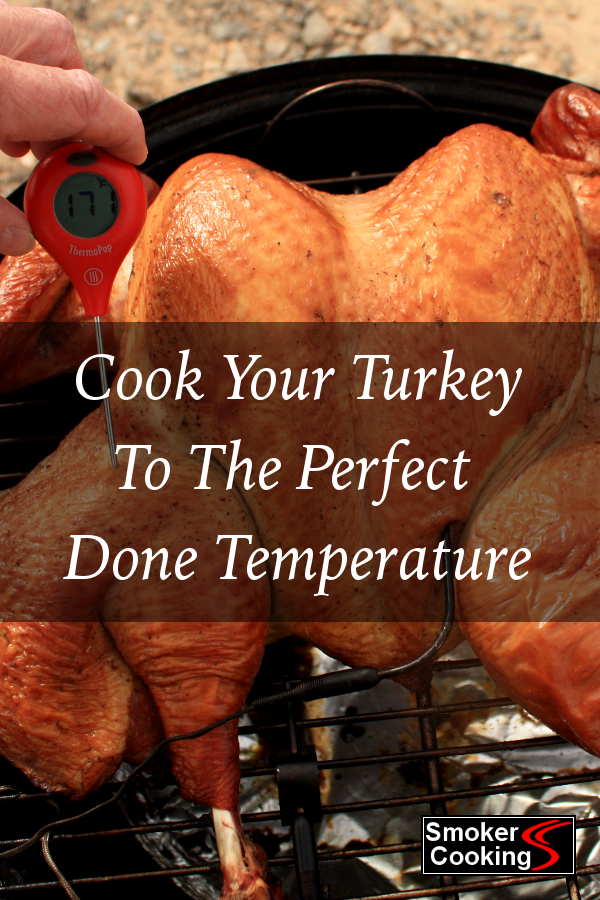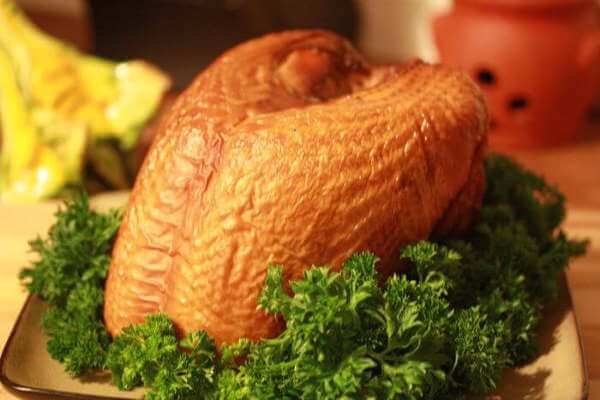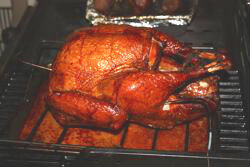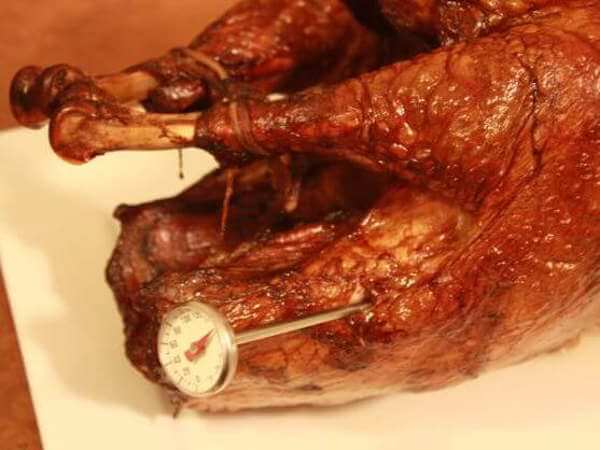The Turkey Done Temperature Target For Perfectly Cooked Turkey
What's the correct turkey done temperature you should aim for? Why is it important that this minimum temperature is reached? What are the possible consequences of under-cooking a turkey?
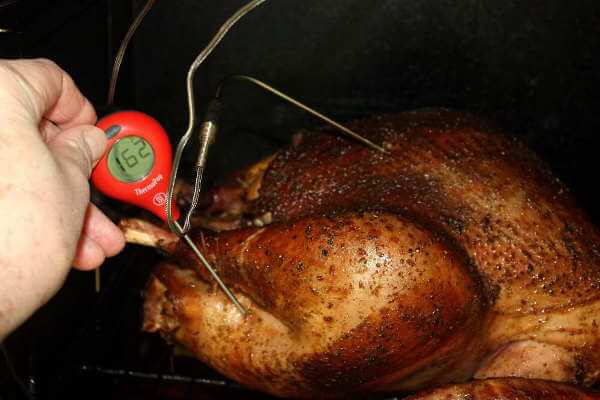 THIS TURKEY THIGH ISN'T QUITE DONE YET!
THIS TURKEY THIGH ISN'T QUITE DONE YET!For years, the FSIS* branch of the USDA** recommended cooking turkeys and chickens to 170ºF internal breast temperature, and 180ºF internal thigh temperature.
Recently that standard has been changed, and now the FSIS recommends that the internal temperature of any part of the turkey has to reach just 165ºF in order to be safe.
That's great news, because the line between being safely done and overcooked (especially for the white breast meat) was extremely narrow at the previous recommendations.
Now there's a little wiggle room for us cookers of turkeys, and there's less chance of serving dry, tasteless turkey breast while still knowing it's completely safe to eat.
*Food Safety and Inspection Service
**United States Department of Agriculture
Turkey Done Temperature- Why So Important?
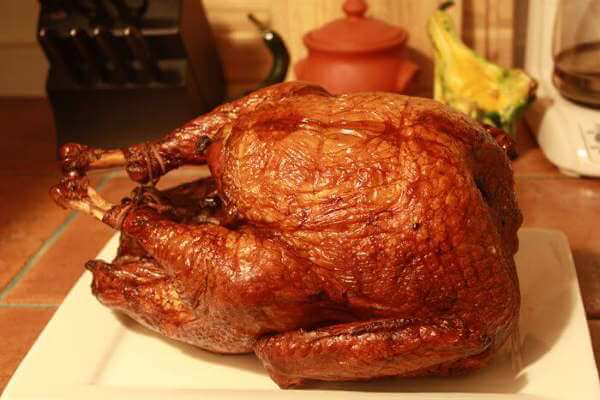
The reason turkey must reach 165ºF is that poultry often carries E-coli bacteria, which can cause serious illness and even death. It's most dangerous when contracted by people who have less robust immune systems.
But it's fully capable of bringing down even extremely healthy individuals (and I mean six-feet-under down). At 165 degrees, any bacteria on or in the turkey is completely wiped out.
One other thing about turkeys, and poultry in general, is that there are lots of nooks and crannies where bacteria can hide. The folds of the wings, under the legs and loose skin, and inside the body cavity and place where even a good rinsing won't remove the hidden bacteria. The only sure way to make poultry safe is to apply adequate heat.
How Temperature Affects Meat Quality
The quality of the breast meat begins to suffer when rises above 165º, losing some of its juiciness and flavor. This is more so for fresh turkeys or frozen turkeys that haven't been pre-basted or pre-brined.
Brining helps poultry remain juicy and moist if it's overcooked a bit, but for the best quality the breast meat shouldn't go over 165º Fahrenheit.
However, the meat of the thigh and leg actually improves in quality when it rises above 165º. Dark meat is forgiving, and can reach up to 180º without a loss of quality.
And in my opinion is actually better cooked to the higher temperature, becoming more fall-apart tender and juicier. Still, if it's cooked to 165º it's safe for all to eat.
How to Check
Turkey Internal Temperature
To test the temperature of the breast, insert the thermometer probe into the deepest part of the flesh, avoiding the breast bone.
The thigh temperature is measured near the joint that attaches to the body of the turkey. Be sure that the probe tip doesn't touch bone.
When To Remove Turkey From the Smoker or Grill
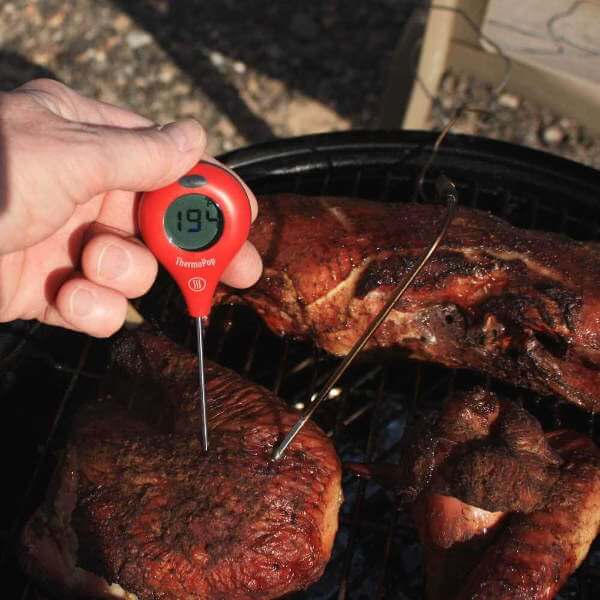 This Turkey Leg Quarter Is Safely Done, and Then Some!
This Turkey Leg Quarter Is Safely Done, and Then Some!The trick of taking the turkey out of the cooker at just the right time is knowing this often overlooked fact:
The internal temperature of meat continues to rise after it's removed from the heat source.
At first it sounds illogical. How in the world could food continue cooking when removed from the smoker, grill or oven?
The reason it happens is due to the temperature variation between the outer surface of the food and the actual internal temperature. In 325 degree oven, when the internal temperature reaches 165º, the surface temperature might be 20 degrees higher.
And when it's taken out, the overall temperature of the food equalizes, and settles at a final internal temperature that's above the internal temp at the moment the turkey is pulled from the cooker.
Some of that excess heat at the surface is lost to the air, but some travels inward, raising the internal temperature. That means that a turkey needs to be taken out when its internal temperature is a bit LOWER than the actual done temperature you're shooting for.
How much lower? That depends on the temperature the turkey was being cooked at. When taken from a 325º oven, the turkey's surface is hotter than it would be when removed from a 250º smoker.
Taken from the oven, the internal temperature could easily rise another 5 degrees, or even more. But that same turkey when removed from your smoker, might only see a internal temperature rise of 2 or 3 degrees.
So to recap:
- The internal temperature of all parts of the turkey must reach at least 165º Fahrenheit to be safe
- White meat is its best when cooked no higher than to 165º
- Dark meat is safe at 165º, but can be cooked to a higher temperature without a loss of quality
- The internal temperature of the turkey rises after being removed from the cooker, meaning that, depending on cooking temperature, the turkey should be removed when its internal temperature is 2 to 5 degrees below 165º Fahrenheit.
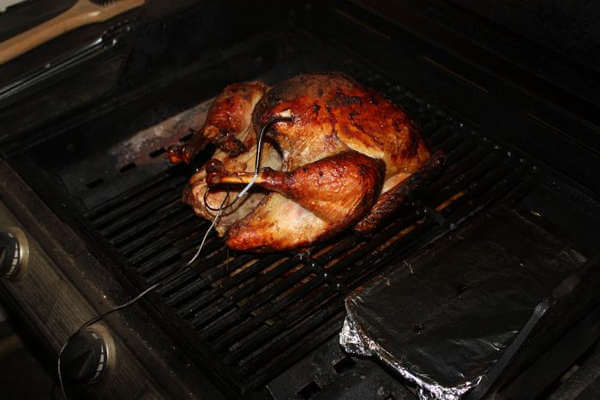
It can be tricky cooking a whole turkey to the proper temperature. The breast usually heats up quicker than the thigh meat. There are techniques that can help, such as cooking the turkey upside down (actually right side up, with the back on top, breast at the bottom).
In grills and smokers, it's common that the temperature of the cooking area varies from top to bottom, or from one side to the other.
In a horizontal pit smoker, it's typically hotter on the firebox end, and can be hotter at the top of the turkey than it is down near the grate.
The same thing goes for gas grills, especially when using the indirect method, with only one burner lit on one end of the grill.
Closer to the flame, it'll be hotter, and since heat rises it will be warmer at the lid than at grate level.
When cooking whole turkeys it's necessary to rotate the bird occasionally, and possibly even flip it over once or twice. I prefer cooking the turkey on a raised rack placed in a shallow baking sheet- it keeps the turkey up out of the juices and at the same time keeps the grill nice and clean.
In my gas grill, I'll cook the whole turkey breast side up for an hour or so, which firms up the skin. Then I'll flip it over and cook it back side up until it's almost ready to take out, when I'll flip it breast side up again to finish, which provides a final crisping of the skin over the breast.
Related Turkey Cooking Tips
- You Are Here: Home >
- Tips >
- Turkey Done Temperature
